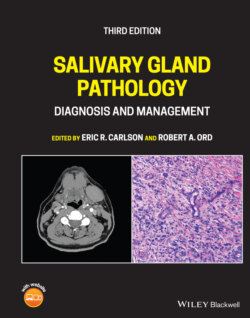Читать книгу Salivary Gland Pathology - Группа авторов - Страница 44
Tubarial Salivary Glands
ОглавлениеIn 2020, Valstar et al reported on the serendipitous presence of bilateral macroscopic salivary gland structures in the nasopharynx of humans. Their existence was visualized by positron emission tomography/computed tomography with prostate‐specific membrane antigen ligands (PSMA PET/CT). The presence of the PSMA‐positive nasopharyngeal regions was elucidated in a retrospective cohort of 100 consecutive patients with prostate or urethral gland cancer. The designated area of the posterior nasopharynx was also studied with hematoxylin and eosin (H&E) and PSMA and alpha‐amylase) immunohistochemistry in two human cadavers. All 100 patients (99 males, one female; median age 69.5, range 53–84) demonstrated a well‐demarcated bilateral PSMA‐positive region on PSMA PET/CT. This 3.9 cm cranio‐caudal structure (range 1.0–5.7 cm) extended from the skull base along the posterolateral pharyngeal wall on the pharyngeal aspect of the superior pharyngeal constrictor muscle with a PSMA‐positive structure located predominantly over the torus tubarius. The tracer uptake in these structures was similar to the uptake of the sublingual glands. The dissected structures from the two human cadavers demonstrated a large aggregate of mucous salivary gland tissue with multiple visible draining duct openings in the dorsolateral pharyngeal wall. The authors concluded that the human body contains a pair of once overlooked and clinically significant salivary glands in the posterior nasopharynx, and the authors proposed the name tubarial glands. Their particular interest in these structures was in gland sparing radiation protocols for head and neck cancer in the best interests of maintaining salivary function and the quality of life of patients.
